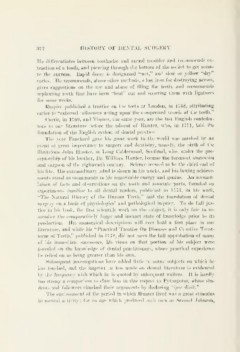Page 412 - My FlipBook
P. 412
373 HISTOEY OF DENTAL SUKGERY
He differentiates between toothache and antral troubles and recommends ex-
traction of a tooth, and piercing through the bottom of the socket to get access
to the antrum. Eapid decay is designated "wot,"" and slow or yellow "dry"
caries. He recommends, above other methods, a hot iron for destroying nerves,
gives suggestions on the use and abuse of filing the teeth, and recommends
replanting teetli that liave been '"beat" out and securing them with ligatures
for some weeks.
Kuspini pulilished a treatise nn tlie teetli at London, in 1768, attributing
caries to "external influences acting upon the compressed vessels of the teeth.''
Curtis, in 1769, and Timaes, the same year, are the last English contribu-
1ors to our literature before the advent of Hunter, wlio, in 1771, laid the
foundation of the English system of dental practice.
The year Fauchard gave his great work to the world was marked by an
event of great importance to surgery and dentistry, namely, the birth of the
illustrious John Hunter, at Long Calderwood, Scotland, who, under the pro-
ceptorsliip of his brother. Dr. William Hunter, became the foremost anatomist
and surgeon of the eighteenth century. Science seemed to be the cliief end of
his life. His e.xtraordinary mind is shown in his works, and his lasting achieve-
ments stand as monuments to his remarkalde energy and genius. An accumu
lation of facts and observations on the teeth and associate parts, founded on
experiments familiar to all dental readers, published in 1771, in his work,
"Tlie Natural History of the Human Teeth," laid the foundation of dental
surgery on a basis of physiological and pathological inquiry. To do full Jus-
lice to Ids l)ook, the first scientific work on the subject, it is only fair to re-
member the comparativelj' foggy and inexact state of knowledge prior to its
production. His anatomical descriptions will ever hold a first place in our
lilcrature, and while his "Practical Treatise On Diseases and Curative Treat-
ment of Teetli." ]iiiblished in 1778, did not meet the full approbation of many
of liis iinmeiliato successor!?, his views on that portion of his subject were
founded on tlie knowledge of dental practitioners, whose jii'actical experience
lie relied on as being greater than his own.
Subsequent investigations liave added little to many subjects on which he
has touched, and tlie imprint he has made on dental literature is evidenced
by the fre(|uency with which he is quoted by subsequent writers. It is hardly
too strong a comparison to class him in this respect to Pythagoras, whose stu-
dents and followers clinched their arguments by declaring "Ipfir di.rH."
The environment of the period in which Hunter lived was a great stimulus
to mental activity: for an age which jiroduced such men as Saniucl .loliuson.


